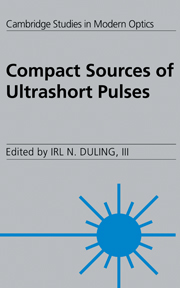Book contents
- Frontmatter
- Contents
- List of contributors
- Acronyms and abbreviations
- Preface
- 1 Short pulse generation
- 2 Passive modelocking in solid state lasers
- 3 Compact modelocked solid state lasers pumped by laser diodes
- 4 Modelocking of all-fiber lasers
- 5 Nonlinear polarization evolution in passively modelocked fiber lasers
- 6 Ultrafast vertical cavity semiconductor lasers
- 7 High power ultrafast semiconductor injection diode lasers
- 8 The hybrid soliton pulse source
- 9 Monolithic colliding pulse modelocked diode lasers
- Index
9 - Monolithic colliding pulse modelocked diode lasers
Published online by Cambridge University Press: 20 January 2010
- Frontmatter
- Contents
- List of contributors
- Acronyms and abbreviations
- Preface
- 1 Short pulse generation
- 2 Passive modelocking in solid state lasers
- 3 Compact modelocked solid state lasers pumped by laser diodes
- 4 Modelocking of all-fiber lasers
- 5 Nonlinear polarization evolution in passively modelocked fiber lasers
- 6 Ultrafast vertical cavity semiconductor lasers
- 7 High power ultrafast semiconductor injection diode lasers
- 8 The hybrid soliton pulse source
- 9 Monolithic colliding pulse modelocked diode lasers
- Index
Summary
Introduction
Compact and lightweight picosecond semiconductor laser sources are needed for high bit-rate time-division multiplexed communication systems (Andrekson et al., 1992), 100 Gbit/s transmission systems (Kawanishi et al., 1993), ultra-long distance soliton fiber transmission (Mollenauer et al., 1991; 1992; Nakazawa et al., 1991), picosecond optical logic gates (Nelson et al., 1991), electro-optic sampling systems (Valdmanis and Mourou, 1986), and opto-electronic generation of millimeter and sub-millimeter waves (Scott et al., 1992). Though there has been substantial progress in the area of ultrashort optical pulse generation using dye or solid state gain media (Ippen et al., 1989; Krausz et al., 1992), semiconductor optical sources are preferred for the above applications because of the following advantages. First, the repetition frequency of interest is usually above 1 GHz, thus substantially shorter cavity length is needed. Second, semiconductor lasers can be electrically pumped, eliminating the need of another pumping laser. Third, the power consumption is very low, typically of the order of 100 mW. No air or water cooling is required. They are also very energy efficient. Typical external quantum efficiencies of semiconductor lasers are between 30% and 90%.
More importantly, the semiconductor gain medium can be integrated with many other optical components using integrated optics techniques. In fact, the whole modelocked laser can be integrated monolithically on a single piece of semiconductor, completely eliminating optical alignment process. This is the main topic of this chapter.
There are two commonly used methods to generate short optical pulses using semiconductor lasers: gain switching (Downey et al., 1987; Lau, 1988a) and modelocking (van der Ziel, 1985).
- Type
- Chapter
- Information
- Compact Sources of Ultrashort Pulses , pp. 383 - 424Publisher: Cambridge University PressPrint publication year: 1995



